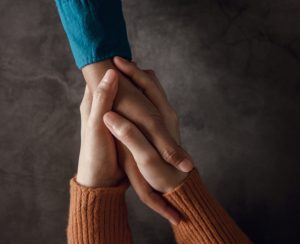‘A History of Being Resilient’

It’s been a rough two years.
Whether you feel surreally suspended in March 2020 or are convinced you’ve somehow aged a decade since then, the upheaval of everyday life has influenced every facet of existence, leaving even those who sidestepped major loss, disruption and medical bills exhausted and wondering how much longer this can last.
There is some renewed optimism about the pandemic waning as many feel more secure in attempting to reclaim elements of their pre-pandemic lives. But even if COVID-19 completely vanished tomorrow, it would simply be the end of the viral pandemic: There are still years of emotional healing and traumatic recovery in store for COVID patients and the general population alike, compounded by an already wanting availability of resources that predates the pandemic’s onset.
“This trauma that we’ve endured is a generational trauma that will linger,” says Marni Stahlman, president of the Mental Health Association of Central Florida (MHACF). “There is unquestionably a post-COVID mental-health crisis, in terms of waves of people that previously were not affected and impacted by a mental-health diagnosis.”
Calling it a “mental health crisis” is by no means an exaggeration, as many of the region’s experts say that’s exactly where we are now—and have been for quite some time.
“People struggled with getting the services they need even before the pandemic,” notes Ray Larsen, Heart of Florida United Way (HFUW) senior vice president of strategic impact and community engagement. “Many more people found themselves experiencing, if not mental illness, then certainly stress, depression, sadness, anger—a lot of feelings we normally wouldn’t have without those experiences of COVID.”
“Now that it’s been two years, we have statistical data on COVID patients … [that] indicates we’ve moved away from the acute let’s-save-the-life to chronic management,” Stahlman notes. “Within three to six months of a COVID patient coming out of recovery, they’re developing symptoms related to anxiety and depression where they may not have had any behavioral or mental health issues before. Additionally, they’re now finding residual neurological damage in COVID patients.”
Larsen refers to HFUW’s emergency hotline, which provides necessary resources and crisis support and also serves as a suicide prevention lifeline, as “the canary in the coalmine:” “We start seeing things a little bit earlier there than other circumstances, and I can tell you that we certainly saw a dramatic increase in calls: The calls that we got per day went up 400%. … so that was a pretty early indication that this [pandemic] was impacting people’s lives.”
As COVID’s spikes came in waves, so did its accompanying emotional toll. Those who might have been able to handle weeks or even months of unprecedented uncertainty watched their stability evaporate in an unclear future stretching endlessly ahead, often agitating old frustrations.
“It was a major change for a lot of people that brought to light a lot of long-standing issues,” observes Ann-Marie Miglionico, a licensed clinical social worker who founded Tranquil Waters Counseling. “A lot more people experienced couples’ problems and marital problems because they were faced with having conversations that they’d managed to avoid dealing with before, or parents were struggling with supervising their kids’ remote education while also working from home.”
A once-in-a-lifetime global health crisis has profound ramifications for those who have lived through it and now have to grapple with any combination of survivor’s guilt, financial hardships, long-haul COVID, shuttered jobs, shattered lives, back-and-forth public guidelines and all the other signs that life won’t return to a pre-pandemic kind of normal anytime soon.
As Florida was already in a disadvantageous position—the state ranks 49th in the country for mental-health funding—individual donors and nonprofits have attempted to mitigate that crisis before it spirals further. New programs and initiatives have been established with the specific goal of combating the mental-health issues that are direct consequences of COVID: For example, MHACF worked with the Central Florida Foundation to launch its You Are a Lifeguard campaign, a multichannel program specifically geared toward ensuring that area youth and young adults who are struggling with mental illness and suicidal thoughts get the immediate, nonjudgmental help they need.
HFUW had been contracted by Orange County Mayor Jerry Demings and its commissioners to analyze the county’s mental health system, identifying shortcomings and providing actionable suggestions for improvement. After receiving the largest donation in its 83-year history—a $20 million financial gift from philanthropist McKenzie Scott—HFUW committed $1 million of that to launching a “culturally competent mental health campaign focused on breaking down the stigma of getting help,” including a program that will better equip the community with mental-wellness tools in response to the Orange County Government’s Mental & Behavioral Health System of Care Community Analysis report.
“It usually takes about a decade before someone who started experiencing mental-health symptoms actually seeks and gets help,” Larsen explains. “The idea is to raise awareness and have a community campaign to reduce that stigma and overcome those barriers to treatment so people seeking help can get it more quickly.”
While it is encouraging that more people realize they’re worthy of help, the mental-wellness field’s workers are at or approaching their limits, and struggling to do more to meet that increase in need.
“[Our] screenings for depression in adolescents demonstrated an increase of 40 to 50% enterprise-wise from 2018 to 2021 … and office visits related to depression increased by 64%,” notes Dr. Beth Long of Nemours Children’s Hospital. “That is a positive, that people are coming in and asking for help—but how do take care of all these kids? As a psychologist, the worst feeling ever is to say, ‘No, I can’t get you in, I can’t take care of you.’”
It is crucial to remember that it’s not just the adult population struggling to keep their heads above the murky waters of depression, anxiety and even suicidal ideation. Befitting the resilience of children, Long said that the youngest residents’ struggles didn’t really start to emerge right away.
“In my practice, most children and adolescents had adjusted fairly well to quarantining and some other pandemic-related changes, and when I started to see that change was about a year in,” she says. “I think the excitement around the things that they had actually enjoyed, like being with their families and having more time off with a relaxed schedule structure, had worn off as they began to face the ‘new normal’ and realized that everything had changed, this isn’t just a break from routine.”
But, it is worth noting, the younger generations are proving just how resilient they are and internalizing all the hard lessons to be found in surviving a pandemic. But they are still taking their cues from adults’ attitudes about mental health, making it even more important to talk with them about positive coping skills and encouraging them to accept that it is OK to not be OK.
“We have to give kids permission not to be fine,” Stahlman affirms. “Even as adults, we don’t recover from trauma fast—so why should we ask our kids to?”
After hearing from so many new patients who are opening up about their inner turmoil and taking that often-scary first step of asking a mental-health professional for help, as well as longtime patients who are navigating all-new turbulent waters as part of their ongoing journeys, mental-health professionals are seeing evidence that the cultural hesitancy to address mental health is finally, if not slowly, abating.
“When people are willing to be open to change and motivated to do the work, it continues to decrease the stigma—but there are still many people who don’t believe in the power of working on your mental health,” Miglionico says.
While it’s hard to consider anything about COVID a net positive, it has ushered in other promising developments, like telehealth’s rise in popularity. That resulting, almost ubiquitous usage makes it easier to prioritize self-care, which helps people get the help they need while normalizing it in the first place.
It also puts a professional assessment at the fingertips of individuals with mobility limitations or compromised immune systems, which is a boon for accessibility—which is becoming a wider concern as long-COVID creates a greater need for disability care.
“What it did was create equity in care in terms of access and availability,” says Stahlman. “The convenience and accessibility factors have been really positive for the normalization in saying ‘I have to go over here for 45 minutes, I have a session with my therapist.’”
And the more people feel comfortable taking those first steps toward better mental health, the less of a stigma surrounds both asking for help and needing it in the first place.
“What COVID has done is humanize what mental health and wellness is about and identify that we all have mental health, just like we all have physical health, and that both been to be maintained in positive ways,” says Stahlman. “People are understanding that trauma is a thing that’s happening to you, it doesn’t mean you’re inherently broken.”
“I think that Central Florida has shown that it has a history of being resilient and pulling together—and taking care of each other,” Larsen adds. “This is a life-altering experience that we’ve lived through together but if I was going to bet on any community, I’m going to bet on our community.”






